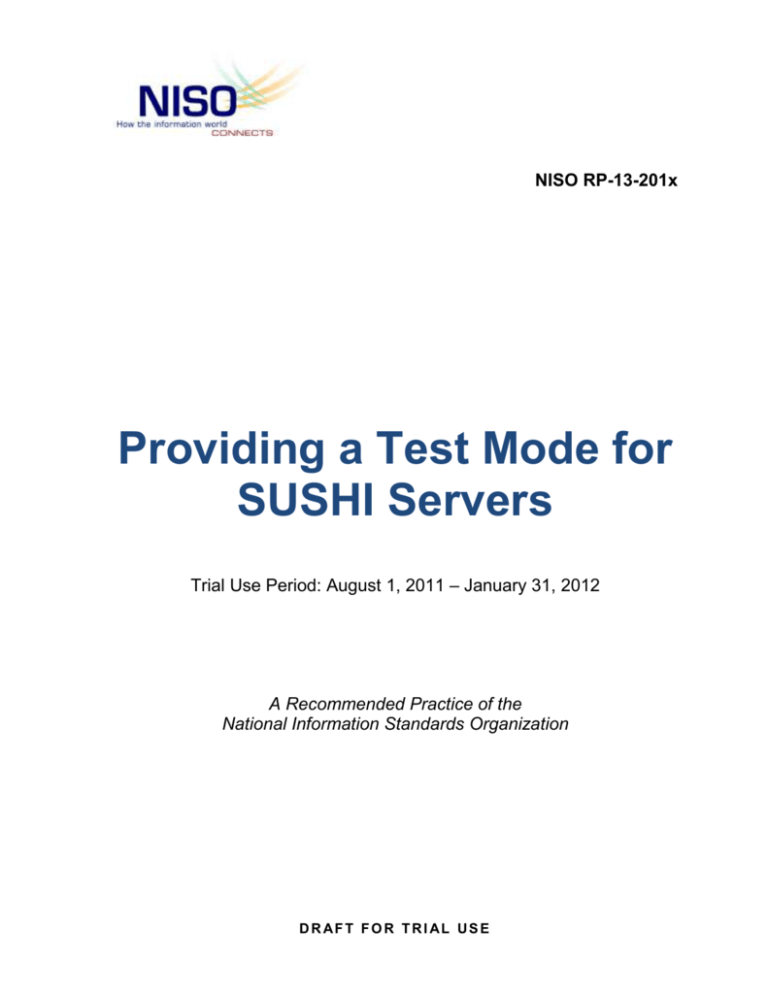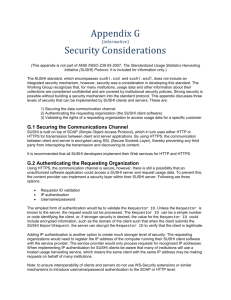
NISO RP-13-201x
Providing a Test Mode for
SUSHI Servers
Trial Use Period: August 1, 2011 – January 31, 2012
A Recommended Practice of the
National Information Standards Organization
D R AF T FO R TRI AL US E
NISO RP-13-201x
About NISO Recommended Practices
A NISO Recommended Practice is a recommended "best practice" or "guideline" for methods,
materials, or practices in order to give guidance to the user. Such documents usually represent a
leading edge, exceptional model, or proven industry practice. All elements of Recommended
Practices are discretionary and may be used as stated or modified by the user to meet specific needs.
This recommended practice may be revised or withdrawn at any time. For current information on the
status of this publication contact the NISO office or visit the NISO website (www.niso.org).
Published by
National Information Standards Organization (NISO)
One North Charles Street, Suite 1905
Baltimore, MD 21201
www.niso.org
Copyright © 2011 by the National Information Standards Organization
All rights reserved under International and Pan-American Copyright Conventions. For noncommercial purposes
only, this publication may be reproduced or transmitted in any form or by any means without prior permission
in writing from the publisher, provided it is reproduced accurately, the source of the material is identified, and
the NISO copyright status is acknowledged. All inquiries regarding translations into other languages or
commercial reproduction or distribution should be addressed to:
NISO, One North Charles Street, Suite 1905, Baltimore, MD 21201.
Printed in the United States of America
ISBN (13): to be added at publication
D R AF T FO R TRI AL US E
NISO RP-13-201x
Contents
Foreword
iv
Section 1: Introduction
1
1.1 Purpose and Scope ................................................................................................... 1
1.2 Terms and Definitions ................................................................................................ 1
Section 2: Expectations for SUSHI Servers
3
2.1 Registration Requirements for Client Testing ............................................................. 3
2.1.1 Requirement for Registration.......................................................................... 3
2.1.2 Registration process ...................................................................................... 3
2.1.3 Registration Instruction Included on SUSHI Server Registry .......................... 3
2.2 Relationship Between the Test Server and the Production Server ............................. 3
2.2.1 The Test Server May Be a Separate Instance ................................................ 3
2.2.2 Test Server Must be Technically Equivalent ................................................... 3
2.2.3 Test Server Does Not Need To Offer Equivalent Data ................................... 4
2.3 Security Considerations ............................................................................................. 4
2.4 Operational Considerations ....................................................................................... 4
2.4.1 Requestor ID and Customer ID ...................................................................... 4
2.4.2 Report Definitions........................................................................................... 4
2.4.3 Usage Date Filters ......................................................................................... 4
2.4.4 COUNTER Reports To Be Returned in the Response ................................... 4
2.4.5 Error Reporting .............................................................................................. 5
2.5 Logging of Client Activity on the SUSHI Server .......................................................... 5
DRAFT FOR TRIAL USE
iii
NISO RP-13-201x
Foreword
About this Recommended Practice
The Standardized Usage Statistics Harvesting Initiative (SUSHI) Protocol standard (ANSI/NISO
Z39.93-2007) defines an automated request and response model for the harvesting of electronic
resource usage data utilizing a Web services framework. The protocol specifies how a SUSHI client
makes a request to a SUSHI Server and how the server responds to the client.
During the development of a SUSHI client, it is often time-consuming and, in general, difficult to get
test credentials on the servers that the client intends to harvest usage from. In some cases access to the
server is restricted due to the sensitive nature of the usage data. Some servers restrict the number of
requests that can be submitted in a 24 hour period by a client, limiting the amount of testing. And
even if servers do not restrict access, repeated tests on the part of a client may also add unnecessary
strain on the server.
The SUSHI Standing Committee, whose role is to maintain the standard, promote its usage, and
educate and assist implementers, proposed that a SUSHI Servers Working Group be established to
develop a recommended practice for how Content Providers would provide access to their SUSHI
Servers in a “test” mode. This proposal was approved by the Business Information Topic Committee
in January 2011.
This recommended practice is the SUSHI Working Group’s deliverable. It describes how the server
would be expected to behave normally (e.g. issuing errors when appropriate and responding with
reports when appropriate); however, rather than delivering live usage data, they would just deliver
sample reports. The expectation is that developers of clients would be able to get test credentials with
minimal effort and that authentication requirements for the server running in test mode would be
relaxed.
The overall objective is to make it easier for SUSHI Clients to be developed by reducing and
eliminating common roadblocks. The advantage to the Content Provider is that it spends less time
supporting Client Developers. Successful implementation of SUSHI means more accurate and
timelier reporting. It is also in the Content Provider’s interest for librarians to have easy access to the
necessary usage statistics to make informed collection development decisions.
NISO Topic Committee Members
The Business Information Topic Committee had the following members at the time it approved this
Recommended Practice:
[to be added by NISO after approval]
iv
DRAFT FOR TRIAL USE
NISO RP-13-201x
NISO SUSHI Servers Working Group Members
The following individuals served on the NISO SUSHI Server Working Group, which developed and
approved this Recommended Practice:
Oliver Pesch (chair)
EBSCO Information Services
Paul Needham
Cranfield University
Bob McQuillan
Innovative Interfaces, Inc.
Xiaochun Xing
Swets Information Services
John Milligan
ScholarlyIQ
Acknowledgements
The SUSHI Servers Working Group wishes to acknowledge those outside the formal working group
membership who contributed to this effort.
[to be added to final document as needed]
Trademarks, Services Marks
Wherever used in this standard, all terms that are trademarks or service marks are and remain the
property of their respective owners.
DRAFT FOR TRIAL USE
v
NISO RP-13-201x
vi
DRAFT FOR TRIAL USE
NISO RP-13-201x
Section 1: Introduction
1.1 Purpose and Scope
These recommended practices are intended to promote the adoption of the SUSHI standard by
making it easier for developers to create SUSHI client software—applications that can harvest and
analyze COUNTER reports.
This objective will be met by providing a series of recommended practices that Content Providers can
follow to improve the accessibility of their SUSHI Servers to Client Developers. Accessibility will be
improved by providing a test version (or test mode) for the SUSHI Sever; by simplifying or
eliminating the need for a SUSHI Client to be registered before it can access the test version of the
SUSHI Server; and by providing technically equivalent responses to SUSHI Requests. The test
version is not expected to respond with actual customer data.
The goal is to remove as many barriers as possible for the developers so that they can more rapidly
develop and test the fundamentals of their client software using test data.
This document acknowledges that final testing of any client can only be performed on production data
and for this, the SUSHI Server will need to impose the security measures needed to protect customer
data.
1.2 Terms and Definitions
The following terms, as used in this recommended practice, have the meanings indicated.
Term
Definition
Client Developer
A person who is creating an application that will act as a
SUSHI Client that will retrieve information from the SUSHI
Server.
Content Provider
The organization that provides COUNTER usage statistics on
behalf of a publisher. For the purposes of this document, this is
the organization responsible for the SUSHI Server and
providing a test instance or test mode for that server.
COUNTER report
A usage report formatted to the specifications set out in the
COUNTER Code of Practice that is delivered as the payload of
the SUSHI response. With SUSHI, the COUNTER report is an
XML document formatted to the COUNTER schema.
exception
In the context of SUSHI, an element within the SUSHI Schema
for the SUSHI Response used to report to the client an error or
other condition that indicates there were issues with completing
the request.
NOTE: An exception may be issued even though a COUNTER
report is included with the Response; it could indicate that the
Response differs from the Request.
production server
An instance of a SUSHI Server used to retrieve actual customer
usage data.
DRAFT FOR TRIAL USE
1
NISO RP-13-201x
Term
Definition
SUSHI
Standardized Usages Statistics Harvesting Initiative. A NISO
standard (ANSI/NISO Z39.93). For more information, see
www.niso.org/workrooms/sushi
SUSHI Client
Software that retrieves COUNTER reports from a SUSHI
Server using the SUSHI standard. Typically used in conjunction
with applications that store and analyze usage.
SUSHI Request
An XML message sent by the SUSHI Client to the SUSHI
Server requesting the delivery of a COUNTER XML report for
a specific customer.
SUSHI Response
The XML message returned by the SUSHI Server to the SUSHI
Client. The SUSHI Response includes information about the
Request, the COUNTER report (embedded as an XML
document within the response), and may include one or more
exceptions to indicate problems with the Request itself or
processing of the Request.
SUSHI Server
A web service provided by a Content Provider for delivering
COUNTER usage reports. Functionality is dictated by the
SUSHI standard.
SUSHI Server registry
A website (http://sites.google.com/site/sushiserverregistry)
where Content Providers register details about their SUSHI
Servers.
test server
An instance of the SUSHI Server (or an operational mode) that
can be used to retrieve test data. The test server will not deliver
actual data and will have less rigid authentication requirements.
2
DRAFT FOR TRIAL USE
NISO RP-13-201x
Section 2: Expectations for SUSHI Servers
2.1 Registration Requirements for Client Testing
2.1.1 Requirement for Registration
The Content Provider may choose to require the registration of test clients to control access and offer
debugging assistance by being able to identify the specific client making the request. If the client is
identified in the request via the Requestor ID, then the Content Provider knows who to contact if
there is a problem.
2.1.2 Registration process
If the Content Provider chooses to require the developer to register the client, registration should be a
simple process managed by either an e-mail request or a web form.
In a Request the developer would declare the intent to access the test version of the Content
Provider’s SUSHI Server and would be expected to provide the contact name, contact e-mail,
organizational affiliation, the IP address of the test client, and a short description of the project.
In response the Content Provider would send the developer the URL to the test server, a Requestor
ID, the Customer ID to use, and any other special instructions.
The registration process should take no longer than one business day.
2.1.3 Registration Instruction Included on SUSHI Server Registry
Registration instructions for developers should be made available through the SUSHI Server Registry
as part of the instructions. The SUSHI Server Registry will include an entry for Test Server
Instructions. The instructions could take the form of detailed instructions, a link to a separate web
page with instructions, or an e-mail address for inquiries.
2.2 Relationship Between the Test Server and the Production Server
A Content Provider may choose to offer a separate SUSHI Server for testing. This is acceptable
provided that server is technically equivalent to the production server. Following are points of
clarification.
2.2.1 The Test Server May Be a Separate Instance
The Content Provider, at its option, may choose to keep a separate instance of its SUSHI Server for
testing purposes. In the case where there is a separate instance, the URL to the test server should be
provided in the SUSHI Server Registry or if the client must be registered, the URL may be provided
to the Client Developer at the time the client is registered.
2.2.2 Test Server Must be Technically Equivalent
The test server, or the production server operating in test mode, must operate in a manner that is
technically equivalent to the production server. Specifically, it must:
Support the same reports as the production server
Create SUSHI Responses that are structurally equivalent to the production server
Create COUNTER reports that are structurally equivalent to the production server
DRAFT FOR TRIAL USE
3
NISO RP-13-201x
Respond to error conditions in the same manner as the production server
2.2.3 Test Server Does Not Need To Offer Equivalent Data
The test server must offer representative usage data for inclusion in the COUNTER reports; however,
this data does not need to match production data. The purpose of the test server is to help a Client
Developer in testing system functionality and not to retrieve live data.
2.3 Security Considerations
If the Content Provider offers a test mode that is open to anyone (no registration required), then no
additional security challenges should be imposed.
If the Content Provider wishes to perform IP authentication or require additional security
mechanisms, such as SOAP-level authentication, then it must offer an option for the Client Developer
to register the client. (See section 2.1.)
If the Content Provider’s server includes non-standard authentication methods (i.e., any method that
requires the Client Developer to create or use extensions to the SUSHI protocol), the test server must
also emulate the same methods as the production server so that the Client Developer can make the
necessary customizations to the client software before accessing the production server.
2.4 Operational Considerations
2.4.1 Requestor ID and Customer ID
If the Content Provider requires the developer to register the test client before access is granted, then
the Content Provider will inform the developer of the Requestor ID and Customer ID to use for
testing.
If the Content Provider offers a test mode that is open to anyone (no registration required), the
following values would be expected in the SUSHI Request to use the server’s test mode:
Requestor ID = test
Customer ID= test
2.4.2 Report Definitions
The client would be expected to request valid COUNTER reports. The server would be expected to
return a representative report if the report is supported or respond with the standard error messages
for the standard server error conditions.
2.4.3 Usage Date Filters
The client is expected to provide a valid date range in the request. The server would respond with a
representative report if the dates are within the supported range or the server would respond with the
standard error messages for the standard server conditions, such as: “No Usage Available for
Requested Dates” if the dates are not within the supported range or “Invalid Date Arguments” if the
begin date is greater than the end date. (See section 6.2.3, Exceptions and Errors, in the SUSHI
standard for more on standard error reporting.)
2.4.4 COUNTER Reports To Be Returned in the Response
The Content Provider can, at its option, respond with pre-set test reports for each of the supported
COUNTER reports.
4
DRAFT FOR TRIAL USE
NISO RP-13-201x
Each supported COUNTER report should provide sufficient data to demonstrate the nature and
structure of the response; specifically:
If multiple metric types can be provided, then each metric type should be represented in the
response.
If multiple databases and journals can be provided, then the report should include multiple
entries.
If a request is for multiple months, then the response should include multiple months of data
for each item in the report.
If titles in the report don’t all have identifiers, then it is recommended to include a sample of
titles with and without identifiers.
2.4.5 Error Reporting
When the test server encounters an error condition that results in an exception being returned in the
SUSHI Response, the server should include sufficient contextual information in either the Message or
the Data elements to assist the Client Developer in diagnosing the error. For example, if a report is
not supported, the Exception Number would be “3000” and the message could say that “Report name
submitted (<name-submitted>) is not valid or not supported by this server.”
2.5 Logging of Client Activity on the SUSHI Server
It is recommended that the SUSHI Server log test SUSHI Requests to assist with debugging both the
server and the clients. By recording the test request as well as the server’s response to that request
(including errors generated by the request) the Content Provider can assist Client Developers by being
able to spot errors in the client requests.
NOTE: This recommended practice sets no expectation that requires the Content Provider to offer
debugging assistance to Client Developers; such assistance would at the discretion of the Content
Provider.
DRAFT FOR TRIAL USE
5










